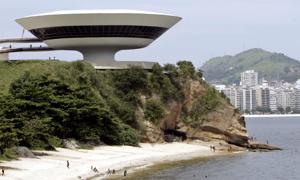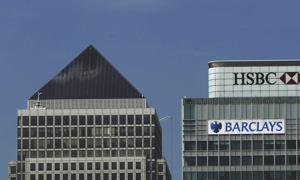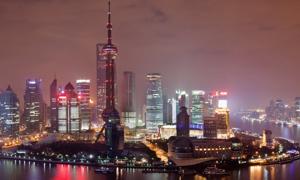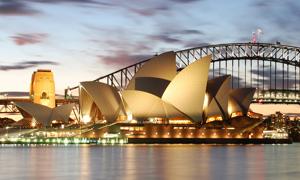History of investment written in the evolving global skyline

Simply sign up to the Property sector myFT Digest -- delivered directly to your inbox.
Property is emerging as a mainstream asset class, and the world’s biggest and most eye-catching buildings are particularly in demand by investors.
The Financial Times’ lead illustration shows a selection of the world’s most famous buildings, reflecting the main markets that we cover. These buildings also provide a window into how the global property industry and its investment trends have evolved over the past century.
Stretching from Depression-era make-work schemes to a business district that has become the subject of a 2014-2015 takeover squabble, these landmarks range from luxury mega-projects to fusions of art and architecture that become tourist attractions.
The global skyline in order
● 1. Golden Gate Bridge
● 2. The MAC
● 3. Willis Tower
● 4 Two World Trade Center
● 5. One World Trade Center
● 6. The Gherkin
● 7. One Canada Square
● 8. Commerzbank Tower
● 9. Petronas Towers
● 10. Burj Al Arab
● 11. BSE Towers
● 12. HSBC Building
● 13. Oriental Pearl Tower
● 14. Sydney Opera House
● 15. Sydney Harbour Bridge
The oldest building in our assemblage is the Sydney Harbour Bridge, started in 1923. The newest, Two World Trade Center in New York, has not yet been built.
The most recent to change hands was London’s 30 St Mary Axe office tower, affectionately known as the Gherkin, bought by a Brazilian billionaire in November for a record price. But most of the buildings in the list have never been put up for sale, demonstrating how hard it can be for investors to find prime buying opportunities.
1
Building: Golden Gate Bridge
Location: San Francisco, USA
Built: 1933-37
Owner: Golden Gate Bridge, Highway and Transportation District
Construction cost: $27m
Last sold: never

Now a symbol of San Francisco’s booming tech economy, the Golden Gate Bridge was originally an icon of economic failure. Constructed in the Great Depression to provide local jobs, the bridge is an example of how property investment can be used as an economic stimulant.
No state or federal funds were involved: it was funded by a $35m bond, which was bought in its entirety by Bank of America after failing to find other investors.
The bond issue was paid off in 1971, with bridge tolls having funded nearly $39m of interest charges as well as the initial $35m principal.
2
Building: Niterói Contemporary Art Museum (aka the MAC)
Location: Rio de Janeiro, Brazil
Built: 1991-96
Owner: Niterói municipality
Construction cost: unknown
Last sold: never

The Niterói, also known as the MAC, is an example of how buildings can become tourist attractions. The flying saucer-style gallery was designed by Oscar Niemeyer, Brazil’s most famous modernist architect, and has become an emblem of the country’s emergence as a global economic power.
Its opening in 1996 foreshadowed the launch the following year of the world’s best-known fusion of art and architecture, Frank Gehry’s Guggenheim Museum in Bilbao, Spain.
3
Building: Willis Tower (formerly the Sears Tower)
Location: Chicago, USA
Built: 1970-3
Owner: Joseph Chetrit and other investors
Sale price: $840m
Last sold: 2004
Naming one of the world’s best-recognised buildings has become a very desirable trinket for many companies. It used to be the convention that a corporation had to take ownership or majority tenancy in a building in order to name it after itself.
But this is changing and the trend was set by insurer Willis when it moved into Chicago’s landmark Sears Tower in 2009.
The company only took three floors in the 108-floor building, but it also secured the naming rights, despite local protests.
4
Building: Two World Trade Center
Location: New York, USA
Built: not yet constructed
Owner: Larry Silverstein, the US property billionaire
Construction cost: unknown
Last sold: n/a
The replacement for the second of the Twin Towers destroyed in the September 11 2001 attacks, Two World Trade Center has yet to be built. After developer Larry Silverstein fought off an attempt by the Port Authority to reduce the building’s scale, the foundations were laid in 2010. But Mr Silverstein is now in search of tenants before committing to the rest of the construction work.
His pause illuminates the difficulty for developers in getting the world’s largest buildings off the ground. Timing the economic cycle correctly can be critical for attracting occupiers and maximising rental income.
5
Building: One World Trade Center (aka “Freedom Tower”)
Location: New York, USA
Built: 2006-14
Owner: Port Authority of New York and New Jersey
Construction cost: $3.9bn
Last sold: never

The replacement for the first of the Twin Towers destroyed in the September 11 2001 attacks, One World Trade Center opened in autumn 2014. The construction of the western hemisphere’s tallest skyscraper has been an expensive saga.
A first round of designs were unpopular with the public; a second round was won by Daniel Libeskind but his proposal underwent years of reworking.
A new subway station underneath the WTC complex has earned the title of the world’s most expensive, costing $4bn, after security and construction plans changed.
Site leaseholder Larry Silverstein fought a series of battles with insurance companies over the policies covering the original World Trade Center towers.
While Mr Silverstein retains control of other parts of the WTC site, the Port Authority has taken ownership of the WTC1 building.
6
Building: 30 St Mary Axe (aka the Gherkin)
Location: City of London, UK
Built: 2001-03
Owner: Brazilian billionaire Joseph Safra
Sale price: £726m
Last sold: November 2014

The Square Mile’s Gherkin became a symbol of the financial crisis when it slid into administration in 2009 and a sign of the London property market’s return to boom times when administrators sold it for a record £726m last autumn.
Joseph Safra, the Brazilian billionaire and the new owner, aims to raise rents and attract high-profile new tenants in order to justify the price he paid.
7
Building: One Canada Square
Location: Canary Wharf, London, UK
Built: 1988-91
Owner: Canary Wharf Group
Construction cost: £624m
Last sold: n/a

Investors’ appetite for property assets, fuelled by their large piles of cash seeking a home with some yield, means they are eyeing ever-larger deals.
The most audacious attempt so far in this property cycle is a joint bid by the Qatar Investment Authority and Canadian fund Brookfield to buy Songbird, the parent company of east London business district, Canary Wharf.
Songbird shareholders are still considering the pair’s final £2.6bn bid, which would give them control of One Canada Square and a clutch of other skyscrapers on the estate.
8
Building: Commerzbank Tower
Location: Frankfurt, Germany
Built: 1994-97
Owner: Commerzbank
Construction cost: DM600m
Last sold: never

The world’s first “green” skyscraper was an early leader in highlighting the contribution that buildings make to carbon emissions. Buildings are one of the largest classes of carbon emitters, after transport and energy production.
As governments around the world continue to tighten emissions standards, buildings that are cheaper to operate and can continue to be occupied are likely to see their values rise.
9
Building: Petronas Towers
Location: Kuala Lumpur, Malaysia
Built: 1993-96
Owner: KLCC Property Holdings, a publicly listed real estate investment trust
Construction cost: $1.6bn
Last sold: never

Property is gradually evolving from being an alternative asset class into the mainstream. This is pushing many owners and operators to go public, in order to attract as wide a range of investors as possible.
The Petronas Towers make up one of the world’s most famous publicly listed property assets but this has not helped their stock’s performance recently. Over the past year the shares have underperformed the main Malaysian stock market index, the KLCI, which has itself fallen in the past six months.
10
Building: Burj Al Arab
Location: Dubai, UAE
Built: 1994-99
Owner: the Jumeirah hotel chain (a subsidiary of Dubai Holding)
Construction cost: $650m
Last sold: never

Countries with spare cash and nowhere to put it have to build their assets. The construction of the Burj Al Arab by Dubai Holding, owned by the ruler of Dubai, kicked off a string of other ritzy and ambitious construction projects.
The proliferation of mega-projects pushed Dubai into a property boom that ended with a catastrophic bust when the financial crisis hit.
11
Building: Phiroze Jeejeebhoy Towers, aka BSE Towers
Location: Mumbai, India
Built: 1980
Owner: the Bombay Stock Exchange
Construction cost: unknown
Last sold: never

Built to house the Bombay Stock Exchange, BSE Towers has become a symbol of India’s financial sector.
The exchange to which it is home has rallied strongly in the past year, as investors anticipate that Narendra Modi, prime minister, will carry out economic reforms.
12
Building: HSBC Building
Location: Hong Kong
Built: 1983-85
Owner: HSBC
Construction cost: $780m
Last sold: never
Renowned British architect Sir Norman Foster stepped on to the international scene with Hong Kong’s HSBC Building, his first foreign commission.
The financial boom of the 1980s saw the rise of the “starchitect” — architects whose big-name stature wins commissions from around the world, for buildings that become symbols of the cities in which they are constructed.
13
Building: Oriental Pearl Tower
Location: Shanghai, China
Built: 1991-94
Owner: Shanghai Oriental Pearl Group
Construction cost: unknown
Last sold: never

The transformation of Shanghai’s waterfront over the past three decades is just the most visible example of China’s evolution into one of the world’s biggest property markets.
From 1990 onwards, the Lujiazui district, opposite the historic Bund, grew from a low-rise area of warehouses and factories into mainland China’s best-known concentration of skyscrapers.
The Pearl was the first landmark to be built and is still the most widely recognised.
14
Building: Sydney Opera House
Location: Sydney, Australia
Built: 1959-73
Owner: New South Wales Government
Construction cost: A$102m
Last sold: never

Nothing good is ever easy — that certainly would be the motto of the team that built the Sydney Opera House.
A series of delays, engineering problems and political clashes meant that the building was completed 14 years after construction first began.
As one of the most recognised symbols of Australia, the opera house also stands as a warning to today’s property investors — turning dreams into reality can be a costly business.
15
Building: Sydney Harbour Bridge
Location: Sydney, Australia
Built: 1923-32
Owner: New South Wales Government
Construction cost: A£10.1m
Last sold: never

The Depression-era bridge was funded with government debt and relied on tolls to repay its construction costs. After the debt was paid off in the 1980s, the charge was kept in place and the funds raised were used to pay for the cost of a new 2.3km harbour tunnel to take some congestion pressure away from the bridge.
Unlike the bridge, the tunnel was built and is operated as a public-private partnership. Kumagai Gumi, Transfield and Tenix are the private companies involved in the A$670m contract.
Back to the top of the page
Comments